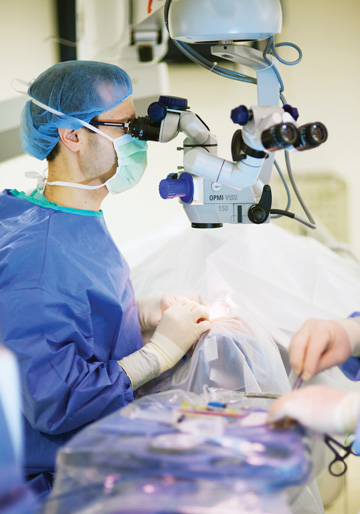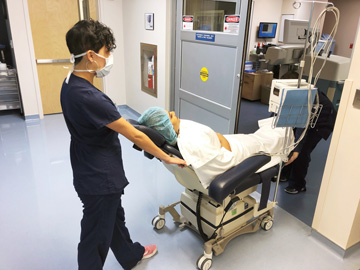Performing immediate sequential bilateral cataract surgery (ISBCS) offers plenty of potential benefits. Surgeons appreciate being able to halve post-op visits while providing cost-effective patient care. Surgery center administrators value the boost to operational efficiencies and freeing up slots on the schedule for more cases. Patients love the convenience of having to plan around and endure only one surgical experience. There’s a lot to like about performing back-to-back procedures on the same day, but significant barriers are preventing it from becoming routine.
- Home
- The Magazine
- Article
Will Same-Day Bilateral Cataract Surgery Catch On?
By: Joe Paone | Senior Editor
Published: 5/5/2022
Proponents laud clinical efficiencies and satisfied patients, but reimbursement hurdles keep the practice at the margins.
Two for the price of one
Medicare and commercial insurers have discouraged the widespread adoption of ISBCS. Medicare pays facilities 100% for the primary cataract procedure, but only 50% for the second case if it’s performed on the same day. Private payers have mostly followed suit. As a result, according to the American Academy of Ophthalmology (AAO), ISBCS comprises just 2.4% of U.S. cataract surgeries.
“That 50% decrease in reimbursement for the second eye can result in a net loss for the surgeon or the surgery center,” says Sloan Rush, MD, ABO, an ophthalmologist with Rush Eye Associates in Amarillo, Texas. Dr. Rush adds that increased clinical efficiency doesn’t come close to covering the financial gap. As a result, he only practices ISBCS in certain circumstances, such as when patients pay cash or must travel long distances.
Dr. Rush recently surveyed patient attitudes regarding ISBCS, finding most were amenable to the procedure; just over half were willing to accept potential ocular health risks to have it. “When you look at it from the patient’s perspective, it adds up to a lot less travel time,” says Dr. Rush, who serves many patients living in rural areas of Texas and New Mexico. “If you’re driving 150 miles one way and need to get a hotel room to have the procedure done on the right eye, and then you need to turn around a week later and do the same thing for your left eye, the costs add up.”
Half of the cataract surgeries in the U.S. would be done the same day if the second eye was paid 100%, according to Daniel Terveen, MD, an ophthalmologist at Vance Thompson Vision in Sioux Falls, S.D. Dr. Terveen successfully performed ISBCS on veterans while at the University of Iowa. “The beauty of doing it at the VA is that you don’t need to worry about insurance reimbursement because it’s a capitated system,” he says. Like the VA, HMOs — Kaiser Permanente is a notable example — are better positioned economically to provide ISBCS because they are paid to provide care for a population as efficiently as possible, so reimbursement levels are less of an issue.
The American Society of Cataract and Refractive Surgery (ASCRS) is consulting CMS’ Center for Medicare and Medicaid Innovation (CMMI) and Alternative Payment Model (APM) experts regarding the reimbursement issue. Dr. Terveen is cautiously optimistic about efforts to establish an APM. “The problem is, how do you make it work for all stakeholders?” he says. “There needs to be a cost savings for CMS, but it also needs to be beneficial for the surgery center, the surgeon and the patient. I think it’s a couple years away before CMS decides if it would go with an APM, and then private insurers would follow.”
For now, Dr. Terveen generally only performs ISBCS on patients who are severely disabled, have difficult travel issues or require general anesthesia, as well as occasional “premium” patients who can afford to pay in cash. “In the vast majority of cases, however, there’s just no economic way from the facility side to make it work,” says Dr. Terveen. “You unfortunately need to lose money to perform ISBCS.”

Daniel Terveen, MD, and his colleagues at Vance Thompson Vision don’t perform immediate sequential bilateral cataract surgery, but rather a modified version. “Patients come for a pre-op visit for both eyes. We do one eye that same day, they stay overnight in a hotel, and we do their other eye the next day,” he says. “It’s a lot less travel and they’re back to work sooner. Plus, there’s not a period where they have differences between the vision in both eyes, which is risky for falls with the elderly. It’s not a huge financial hit for the surgery center, so it’s a win-win-win.”
Dr. Terveen explains to inquisitive patients that he personally would elect to have same-day bilateral surgery. “Unfortunately, however, insurance doesn’t pay for both eyes to be done in the same day, so we typically do them one day apart,” he tells them. “We’ve found we get a lot of the benefits doing it one day apart with the same amount of safety. If you want insurance to cover your second eye, that’s how you have to do it.”
Samuel Masket, MD, has employed a three-day system. “Typically, it was surgery one day, follow-up the next day, surgery a day later for out-of-town patients and those who had a high degree of optical error,” says Dr. Masket, clinical professor of ophthalmology at UCLA Geffen School of Medicine and founding partner of Advanced Vision Care in Los Angeles. “That was a highly successful strategy, as surgeons can most often tell in a day whether the patient has a significant optical error or marked undesired side effects with a given lens.”
— Joe Paone
Proper protocols

Dr. Terveen says the established protocol for safe ISBCS is to treat each eye as a separate surgery. After the first eye is completed, the patient stays put as the surgical team cleans the OR and brings in a new set of instruments. “You don’t need to reposition the patient or the microscope,” he says. “The patient lays in place for a few minutes while there’s a lot of activity around them, and then you begin the procedure on the second eye.” He says some surgeons do the first eye on one patient, go to another OR to do the first eye on a second patient, and come back to do the first patient’s second eye with everything ready to go.
Dr. Rush is one such surgeon. “I go into the OR and do the first eye, and then we clean the entire room,” he says. “I leave and go do a case in another room, and when I come back to treat the next eye, it’s like we switched the whole room for a totally new surgery.”
The main patient safety concern surrounding ISBCS, and the primary reason for the described protocol, is the possibility of both eyes developing devastating infections such as endophthalmitis or toxic anterior segment syndrome (TASS). Dr. Terveen doesn’t feel ISBCS presents an inordinate risk. “If you look at the data, you’re more likely to die in a car accident driving to your second surgery or of anesthesia during that surgery than you are to get a bilateral infection in both eyes,” he says. Dr. Rush also believes the risk is negligible when proper protocols are followed.
However, Samuel Masket, MD, clinical professor of ophthalmology at UCLA Geffen School of Medicine and founding partner of Advanced Vision Care in Los Angeles, recently reviewed two case reports of simultaneous cataract surgery where lack of careful patient selection resulted in bilateral infections. While one patient ultimately recovered good vision in both eyes, the other lost vision in both eyes to endophthalmitis and panophthalmitis. Dr. Masket notes both patients were immunocompromised.
“Surgeons who developed the ISBCS concept and attendant rigid safety protocols are careful and earnest,” he says. “They have set a very rigid standard protocol that they follow, and under those circumstances it may be a safe procedure. However, once the idea that it’s safe to do bilateral surgery has been disseminated, some colleagues may not necessarily follow the agreed-upon rigid safety steps, and that’s when patients may get in trouble.”
To go through extensive setup changes between eyes — drapes, disposable supplies and instruments — is time consuming and costly, according to Dr. Musket. “Surgeons and facilities may tend to cut corners until they get burned,” he says. “My sense is we will see more problems once more surgeons are performing bilateral surgery as a routine and not necessarily adhering to the prescribed safety protocols.”
Look before leaping
ISBCS offers great promise, even if for now its acceptance is limited due to financial issues, with lingering concerns about visual outcomes and patient safety requiring further study. Dr. Masket lists what he calls absolute contraindications for ISBCS, including patients who are immunocompromised and those with chronic arthritis, lung disease, certain blood abnormalities, lymphoma, leukemia, nasolacrimal duct obstruction — anything that could promote infection. Dr. Rush agrees that patients deemed medically unstable are not good candidates for ISCBS.
AAO acknowledges that ISBCS patients may experience “undesired optical images or a less accurate refractive outcome in the second eye, requiring further surgical intervention.” Dr. Masket says optical side effects are a concern with ISBCS among patients who are intolerant of diffractive optic IOLs or who develop dysphotopsia after surgery. The good news is that newer light adjustable IOLs can be adjusted postoperatively to optimize refractive outcomes, but they currently remain cost-prohibitive for most patients.
The appeal of ISBCS for Dr. Terveen lies in quicker recoveries to normal vision, as well as less time off work and less travel time for patients and their caregivers. “It’s also good for the healthcare system because we can care for more patients per hour,” he says. “If you look at the vast majority of studies, the visual outcomes, safety and quality are the same as conventional cataract surgery, and there are economic benefits as well.” OSM
.svg?sfvrsn=be606e78_3)
.svg?sfvrsn=56b2f850_5)